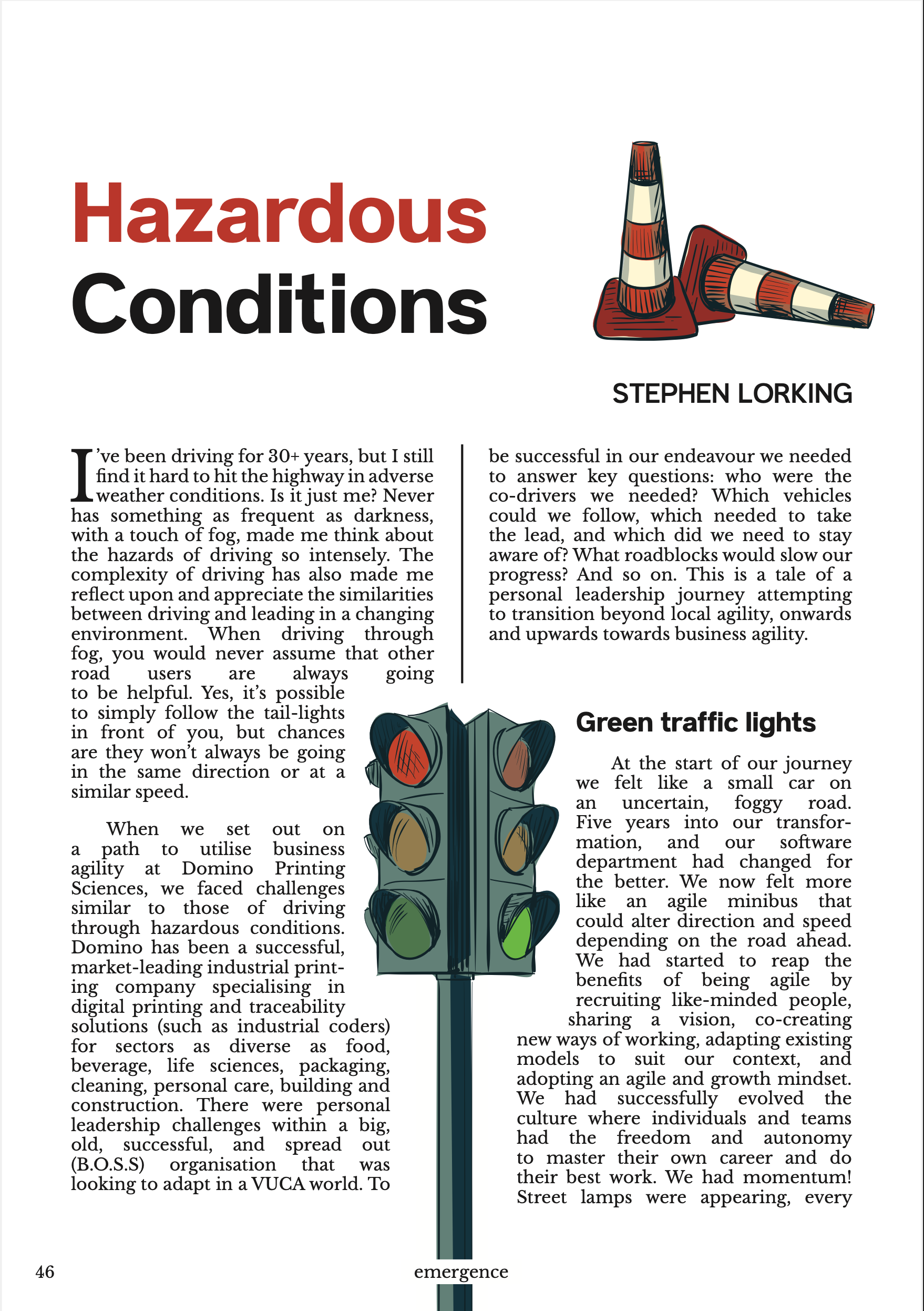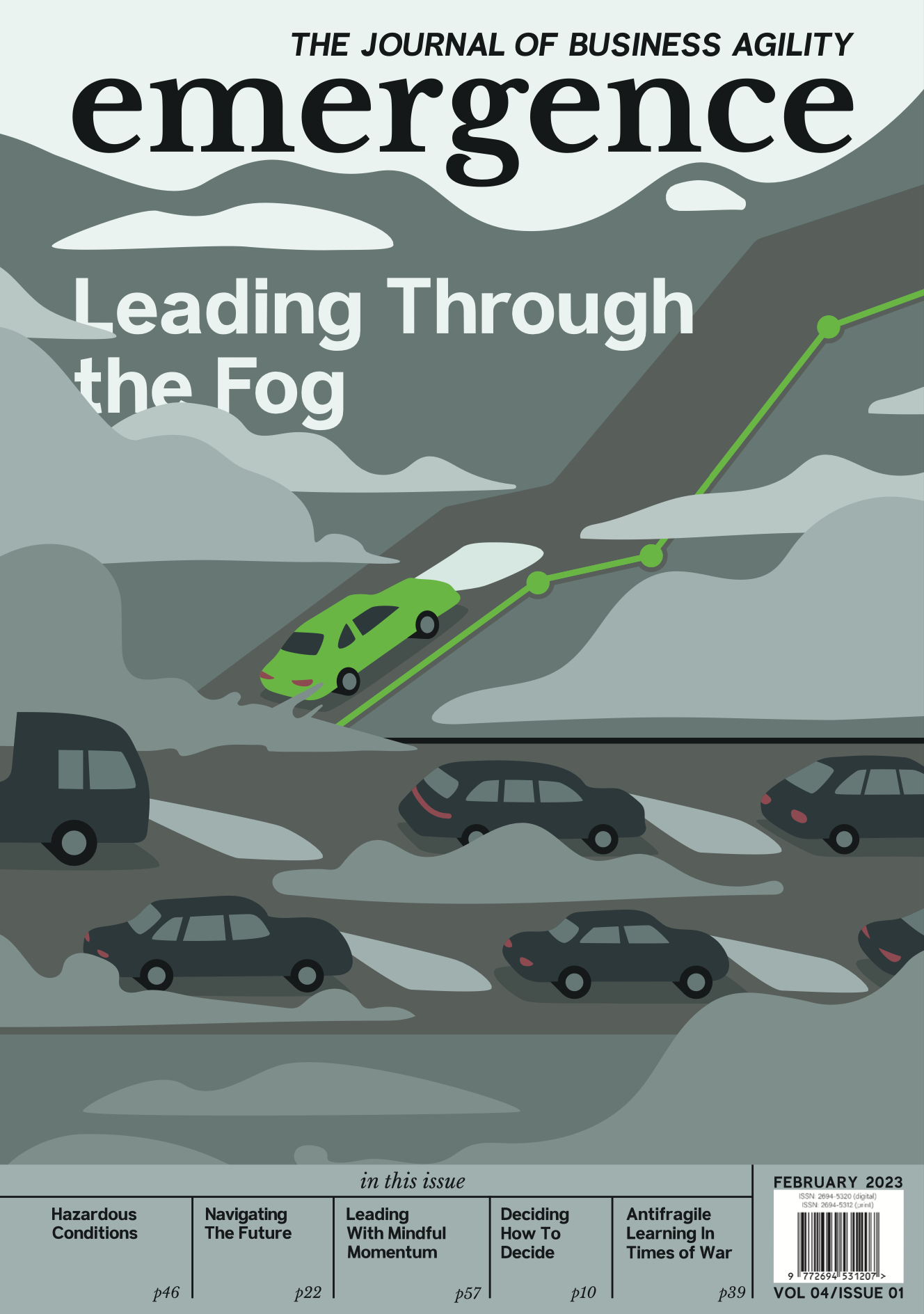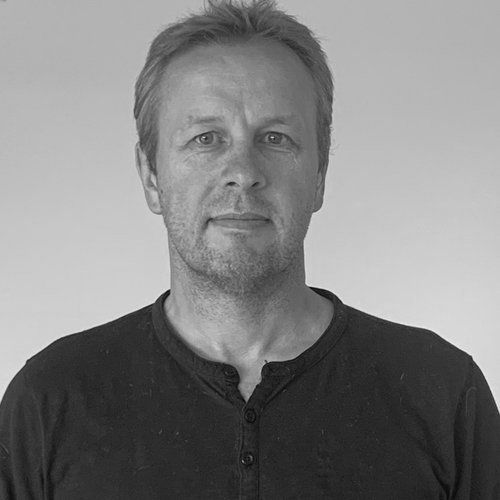Hazardous Conditions
I’ve been driving for 30+ years, but I still find it hard to hit the highway in adverse weather conditions. Is it just me? Never has something as frequent as darkness with a touch of fog made me think about the hazards of driving so intensely. The complexity of driving has also made me reflect upon and appreciate the similarities between driving and leading in a changing environment. When driving through fog, you would never assume that other road users are always going to be helpful. Yes, it’s possible to simply follow the tail lights in front of you, but chances are they won’t always be going in the same direction or at a similar speed.
When we set out on a path to utilise business agility at Domino Printing Sciences, we faced challenges similar to those of driving through hazardous conditions. Domino has been a successful, market-leading industrial printing company specialising in digital printing and traceability solutions (such as industrial coders) for sectors as diverse as food, beverage, life sciences, packaging, cleaning, personal care, building and construction. There were personal leadership challenges within a big, old, successful, and spread-out (BOSS) organization that was looking to adapt in a VUCA world. To be successful in our endeavour we needed to answer key questions: Who were the co-drivers we needed? Which vehicles could we follow, which needed to take the lead, and which did we need to stay aware of? What roadblocks would slow our progress? And so on. This is a tale of a personal leadership journey attempting to transition beyond local agility, onwards and upwards towards
business agility.
Green Traffic Lights
At the start of our journey we felt like a small car on an uncertain, foggy road. Five years into our transformation, and our software department had changed for the better. We now felt more like an agile minibus that could alter direction and speed depending on the road ahead. We had started to reap the benefits of being agile by recruiting like-minded people, sharing a vision, co-creating new ways of working, adapting existing models to suit our context, and adopting an agile and growth mindset. We had successfully evolved the culture where individuals and teams had the freedom and autonomy to master their own career and do their best work. We had momentum! Street lamps were appearing, every traffic light was green, more cars were turning their fog lights on and the future seemed brighter.
However, if we were to strive for wider business agility, we needed to look beyond our own minibus and engage with other road users to help navigate the uncertain road ahead. I recognised we still had a long way to go if we were to replicate our local change at a wider level. This was true for my agile leadership journey too.

Avoiding the Roadblocks
What could go wrong? What possible roadblocks could stop us realising the benefits of business agility? We now had multiple vehicles on this foggy road, all of them different and headed in similar, but subtly unique destinations.
Business units act like large trucks, carrying a heavy load that significantly contribute to business outcomes. However, these trucks are not manoeuvred easily, and their inherent characteristics make it more challenging for them to change even if they wanted to (BOSS). However, we were on the same road, heading in the same direction. Surely these vehicles would travel in unison? And even if they showed some inability to change immediately, my agile leadership development would help me align all these vehicles to meet our common strategic goals.
Well, a year flew past, more grey hairs and wrinkles appeared, and despite a life-time of wisdom gained, the business agility adventure was stuttering. The journey had slowed and our minibus had dents and scratches. Despite our positive launch, missed opportunities and an imperfect leadership approach had sent us off-course.
I reflected on whether these mistakes were deterministic factors of success in our journey. If I hadn’t missed such opportunities or was a more capable leader, could we have been more successful? Maybe not. Other factors much larger than those were also in transit. The large trucks sharing our journey impacted our progress. Our minibus was influenced by the wider system around us. We were constrained to the roads more suited to the larger vehicles (business units) which were unable to see why they should need to change. This forced us to accept that agile teams alone cannot build business agility.
Setting out
To begin this new journey, I knew I needed to develop my leadership capabilities in unison with the leaders of other business units and the C-Suite. The challenge we faced was that our successful agile adoption was in isolation and wasn’t aligned with the rest of the business (which was still in the original mindset of a BOSS business). Therefore, we collectively embarked on agile leadership training that would help create awareness around the need to make a cultural shift as well as a personal one. The thinking was, the more agile leaders we had, the more vehicles we would have to help illuminate and navigate the complexities of transforming our product delivery.
Building on the agile leadership training, we explored key models and concepts that would be the building blocks of our business agility journey; cultural surveys (understanding our current and desired culture), tools that mapped our value streams, thinking models that encouraged focus on work-in-progress and decision making at the right level, and most importantly, a leadership development programme. We aspired to deliver the most valuable work as soon as possible that was aligned with our strategic goals and organisation’s vision.
Assumed Alignment
During the transformation process, I had the opportunity to experience agile leadership training alongside my senior colleagues. As such, it was fair of me to assume that their view of what we needed to do was the same as mine.
Our minibus was brimming with good business agility approaches and an agile and growth mindset focused on visualisation, value delivery, distributed decision making, and collaboration. These capabilities were ready to share, implement, and mature with the large trucks alongside us. Initial progress was good, business agility models and tools were adopted and in use. However, we started to meet resistance. Suddenly the competing culture that was identified in our culture survey started to rear its head. With no common goal or agreed-upon outcome to facilitate back to, we hit a ceiling on exploiting business agility. Confused and concerned, I began to ask questions like “Why try and get business agility in the first place if we weren’t willing to collaborate and work toward a common end?” I thought we were aligned on our goals and approaches.
In an attempt to ease these tensions, I pondered how I could best utilise my leadership learning to influence my senior colleagues and fellow agile leaders. I felt like I knew the way forward but a lack of confidence in working with people above me, not wanting to appear to be an expert in this environment, and the fear of being assertive in an area of conscious incompetence hindered me. I had already taken the lead and introduced visualisation tools and flow models, but I still feared that an expert approach would stifle collaboration.
As such, I began to experiment with power and leadership styles in this new environment. I made intentional changes to use more of a Catalyst Approach, and to better accommodate the senior people I was now surrounded by. Having already offered new thinking models to use, I embraced a more reflective stance and began asking questions to lead them in the direction I thought we needed to go.

The more interactions I had with various different business unit leaders, the more resistance I met. It became apparent that we were not aligned on the outcomes we wanted to achieve from business agility. Their mindset very much was in tension with the mindset we had created within our minibus. Where we valued adaptability and embracing change to help us thrive in a VUCA world, they were struggling to easily see the benefits of being a small, nimble vehicle. We wanted to create an organisation where our minibus could take a diversion through a small town without fear of its ability to get through it. What they hoped for was to squeeze higher productivity out of our minibus and were willing to explore agility to support it, but weren’t yet ready or willing to fully embrace a wider transformational change. Focused on business as usual, they were striving to meet their immediate objectives of delivering to deadlines and, as such, were unable to manoeuvre or shift lanes due to their size and the weight.
Their inability to be more agile meant that we were constrained in the experiments and practices we would explore. For example, we couldn’t experiment with continuous delivery due to well-established processes that forced us to rely on one of these large trucks that could only deliver in monolithic volumes. But because we were forced to co-exist on the same road, we began to clash. The result: scratches and dents in our beautiful minibus.

Leadership Rigidity
Despite this misalignment, there were still benefits we could get from changing the ways we worked together and how we managed the flow of work. I still felt the influence of my agile leadership skills could extend outside our minibus and, hopefully, help align these big trucks.
We experimented by introducing a model to maximise value delivery amongst our biggest product line. This was also a great opportunity for me to practise my leadership styles. We saw some rapid change and had some early wins, such as replacing a limited-value status meeting with a stand-up around a fully-visual board that reflected our value, where it was, and the opportunities for optimisation. This was so much more powerful than what felt like endless discussions on detailed progress reports and status updates.
As this new way of working matured, roadblocks started to appear and progress was impacted. I continued with my approach of guiding and collaborating with others to make change instead of leading as an expert, but it didn’t work. In the time it took for me to share my knowledge, new habits had formed around the use of these models. The organisational process-driven culture took hold. People began reverting to detailed reporting of what they had done, rather than looking at what had changed that would impact flow, or considering what decisions could be made to maximise it. This is another example of trucks stuck on cruise control, unable to change speed or direction. This regression made it infinitely harder to change. Maturity of our use of these models stopped, and although these models had provided many benefits over our previous ways of working, there was still room to grow. We hadn’t yet achieved a strategic goal or achieved better agility.
I aspired to help my peers understand what I knew about these new ways of working and how they would help us optimise flow but I made a fundamental mistake. Without fear of working with my peers, or conscious incompetence in this domain, I assumed a certain leadership style was required. I wanted to be a catalyst that enabled others to learn, and in doing so I failed to give the leaders of the expert knowledge they needed to lead effectively. I needed to traverse my leadership style appropriately instead of thinking a fixed predetermined leadership style was required.
I learned that you don’t have to be a senior leader/director or a C-suite to influence or be a catalyst for organisational change, but you do have to be agile in your leadership approach. That leadership approach has to evolve alongside this organisational change. It has to adapt depending on the environment and people around you. It also is massively influenced by your own internal drivers, motivations, aspirations, and fears.
So What?
With the setbacks suffered above, I retreated back into the comfort zone of our minibus and started applying the lessons learned. A lone minibus driving towards an unknown destination at night in fog is not ideal.
I needed more like-minded people around me who wanted to influence the journey, those that could drive the minibus themselves but also know when to be a co-driver or passenger, which would allow me to sit in the back seat and take time to reflect, help navigate, or just point out the other large trucks we were sharing the road with.
With this in mind, I set out to develop leaders in my team by ensuring they were trained and applying agile leadership in opportunities where they could both succeed and fail. This required me to adapt my leadership and power styles to suit the situation in order to influence the culture at our level, encouraging a business agility mindset; One that wasn’t headed by one leader, but a group of leaders who worked with the teams, and through their leadership behaviours created a stronger agile environment. In interactions with other business units, it wasn’t just myself but engineers within our agile development teams asking the right questions, and offering suggestions about value, priority, work-in-progress, and return on investment decisions.
What Have I Learnt and Would Do Differently?
So here I am today, having pulled over on the side of the road where the fog still looms, reflecting on the journey I’ve just had to navigate.
Leadership is a kaleidoscope of discovery and application, but more importantly, it’s a continuous reflection piece. The biggest (and now most obvious) lesson I have taken from this experience is the way in which I approached the team I led versus the peers and leaders above me. Taking the back seat, ironically, was the biggest driver for my teams’ development, by giving them the responsibility and autonomy to be self-managing whilst supporting them when needed. However, this is not necessarily appropriate when working with peers and others above me. Sometimes I just need to be the driver. The software department’s transformative change resulted in a different culture which was not always aligned to that of the wider organisations, which made it even more important that my leadership style reflected the context I was leading in, rather than assuming a single approach.
Organisational culture and leadership are two sides of the same coin. They are the fundamental pillars that are catalysts for change within an organisation. Even with awareness of the current culture, and a desire to change, it is not enough to guarantee the outcome of change itself.
There are key characteristics of an organisation that I believe can hold back change: policies, structures, metrics, distribution, historical success, size, and history (BOSS). All of these are influenced by the people and their behaviours, especially those of the leaders. Having a culture in one team that tries to drive change and experiment with new ways of working in the same organisation as others who have previously enjoyed the benefits of stability and certainty will cause tension, similar to that of minibuses having dents and scratches from trying to manoeuvre between large, inflexible trucks.
Business agility isn’t a universally understood and commonly agreed definition, and nor should it be. Your context should drive and influence what agility means to you. Even with C-Suite involvement, their participation and sponsorship alone will not overcome some of the fundamental challenges in transformational change, especially if there is a lack of a compelling reason to change. My experience in this organisation has shown that not being truly aligned on what outcomes you want from business agility is likely to lead to wasted opportunities for real change. Therefore I beg you to ask the following question of yourself: What outcomes does your organisation want from business agility, does the entire organisation see the need to change, and how will you be an effective leader in it?
This content was originally published in the February, 2023 Edition of Emergence, The Journal of Business Agility. It has been republished here with the permission of the publication.
What is Emergence?
Emergence is the Journal of Business Agility from the Business Agility Institute. Four times a year, they produce a curated selection of exclusive stories by great thinkers and practitioners from around the globe. These stories, research reports, and articles were selected to broaden your horizons and spark your creativity.








